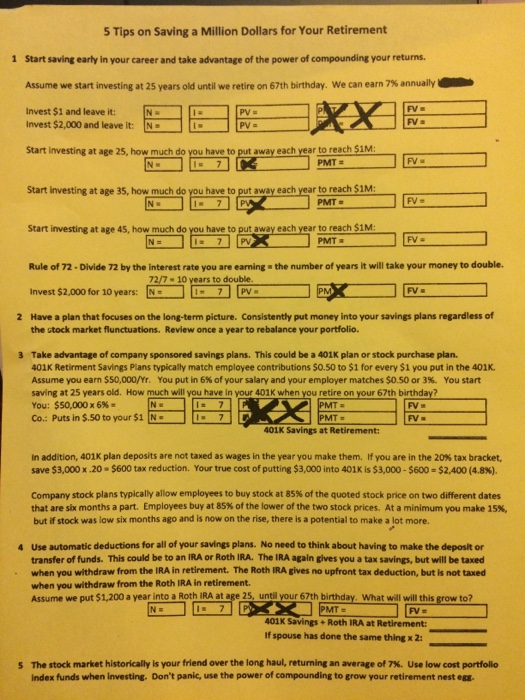5 Tips on Saving a Million Dollars for Your Retirement 1 Start saving early in your career and take advantage of the power of compounding your returns. Assume we start investing at 2S years old until we retire on 67th birthday. We can earn 7% annually FV . Invest $1 and leave it Invest $2,000 and leave it: N Start investing at age 25, how much do you have to put away each year to reach SiM Start investing at age 35, how much do you have to put away each year to reach $1M Start investing at age 45, how much do you have to put away each year to reach $1NM Rule of 72-Divide 72 by the interest rate you are earning the number of years it will take your money to double. Invest $2,000 for 10 years: P PMT [72.7.10 verstod ble. N- invest $2,000 for 10 years: PM Have a plan that focuses on the long-term picture. Consistently put money into your savings plans regardless of the stock market flunctuations. Review once a year to rebalance your portfolio. 2 3 Take advantage of company sponsored savings plans. This could be a 401K plan or stock purchase plan. 401K Retirment Savings Plans typically match employee contributions $0.50 to $1 for every $1 you put in the 401K. Assume you earn SSO,000/Yr. You put in 6% of your salary and your employer matches SO50 or 3%. You start saving at 25 years old. How much will you have in your 401K when you retire on your 67th birthday? You : $50,000 x 6% Co.: Puts in $.50 to your $1 MTa FV 401K Savings at Retirement: in addition, 401K plan deposits are not taxed as wages in the year you make them. If you are in the 20% tax bracket. save $3,000 x .20-S600 tax reduction. Your true cost of putting $3,000 into 401K is S3, -$600-$2,400 (4.8%). Company stock plans typically allow employees to buy stock at 85% of the quoted stock price on two different dates that are six months a part. Employees buy at 85% of the lower of the two stock prices. At a minimum you make 15%. but if stock was low six months ago and is now on the rise, there is a potential to make a lot more. Use automatic deductions for all of your savings plans. No need to think about having to make the deposit or transfer of funds. This could be to an IRA or Roth IRA. The IRA again gives you a tax savings, but will be taxed when you withdraw from the IRA in retirement. The Roth IRA gives no upfront tax deduction, but is not taxed when you withdraw from the Roth IRA in retirement. Assume we put $1,200 a year into a Roth IRA at age 25, untill your 67th birthday. What will will this grow to? 4 MT- 401K Savings+ Roth IRA at Retirement If spouse has done the same thing x2: The stock market historically is your friend over the long haul, returning an average of 7%. Use low cost portfolio index funds when investing. Don't panic, use the power of compounding to grow your retirement nest egg 5







